Family : Cercopithecidae

Text © Dr. Silvia Foti

English translation by Mario Beltramini
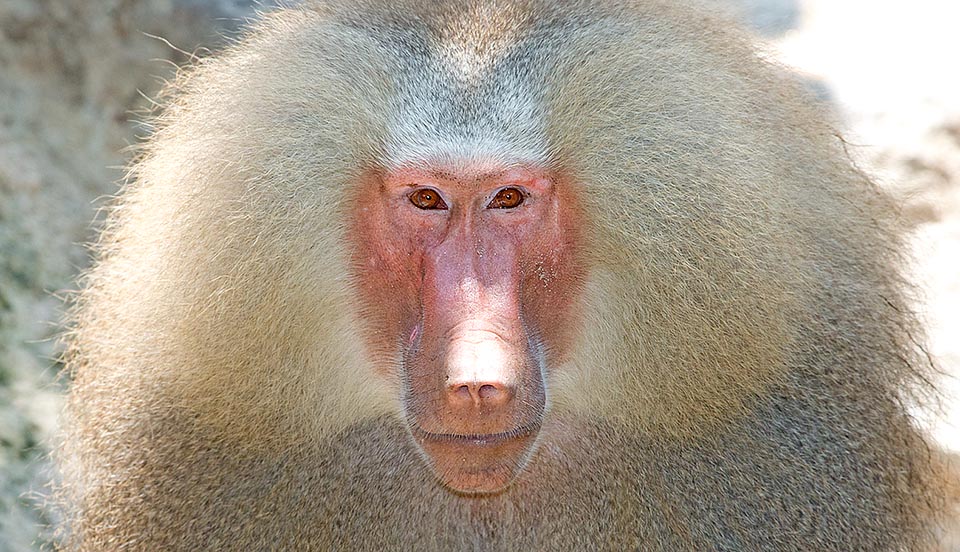
Papio hamadryas is native to the sub desert areas close to the Red Sea, particularly in Ethiopia, Somalia, Eritrea, Saudi Arabi and Yemen. The pale arctic introductions have probably occurred in remote times. In the adult males the head is covered by a long and fluent mane of wavy “hairs” that go down to cover the shoulders. Rightly, this long, characteristic and thick fur distinguishes this monkey from the rest of the baboons, as well as the colour of the face, varying from the red-pink to black © Giuseppe Mazza
The Hamadryas baboons (Papio hamadryas Linnaeus 1758) are catarrhine monkeys native to North Africa, which makes them in all respects the northernmost baboons among the extant ones. They belong to the superfamily Cercopithecoidea and, inside this, to the family Cercopithecidae, in turn subdivided in the subfamilies Colobinae, to which belong the colobuses, and Cercopithecinae, that includes, besides the hamadryas baboons, baboons, macaques, mandrills, mangabeys, geladas, chlorocebus monkeys and patas monkeys. The genus Papio, besides hamadryas baboons, includes the Olive baboon (Papio anubis, Lesson 1827), the Yellow baboon (Papio cynocephalus Linnaeus, 1766), the Chacma baboon (Papio ursinus Kerr, 1792) and the Guinea baboon (Papio papio Desmarest, 1820): all species, but Papyo hamadryas present also in the Arabian Peninsula, do populate the African continent.
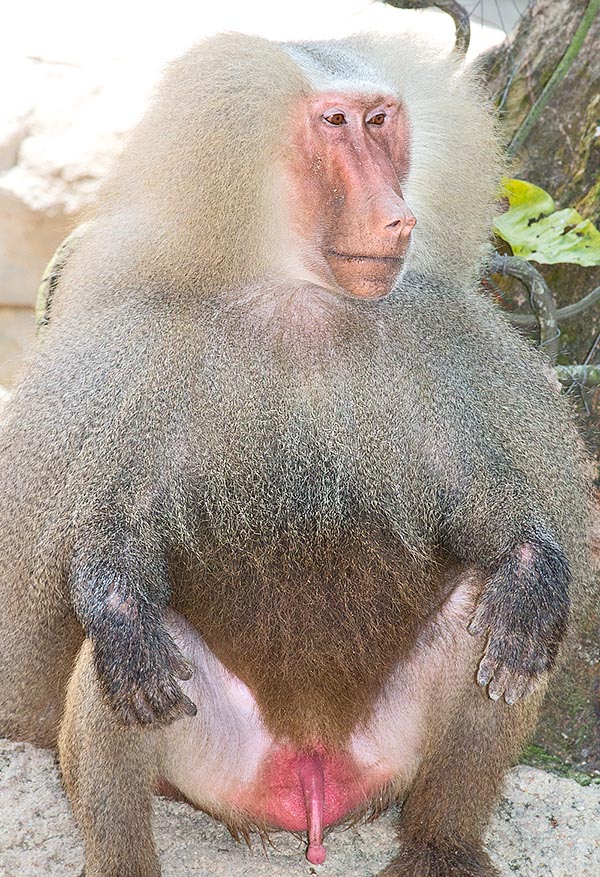
The dominant males, the alpha-males, may have a harem with even 10 females and gather in clans of 60-90 individuals. For spending the night the clans associate then in bands of 200 specimens and sometimes, due to the absence of suitable spaces, in a great aggregation of bands that are called troop © Giuseppe Mazza
The name of the genus Papio comes from the late Latin “papio” = baboon, whilst the specific name hamadryas comes from the Greek ἄμα (ama) = together and δρῦς (drys) = oak, tree, to indicate the Dryades, the nymphs of the trees. Maybe this name has been associated to them because of the habit of sleeping sometimes together on big trees.
Zoogeography
The hamadryas baboons are present in the African continent, particularly in the regions south to the Red Sea, in Ethiopia, Somalia and Eritrea, but also in the Palearctic region, in Saudi Arabia and in Yemen.
They live in the sub-desert regions, the steppe areas, the savannahs and the mountains facing the Red Sea, up to 1500 m of altitude, and their distribution appears strongly conditioned by the presence of water ponds and of cliffs and rocks suitable for being exploited as night shelters.
In some Ethiopean regions, Papio hamadryas are regular visitors of farmlands, so much to be considered as “parasites” of the cultivations.
For what concerns their presence in the Palearctic regions, it is thought that they have been introduced there by the man at the time of the ancient Egyptians, despite the fact that presently they are considered as endemic to the area.
Morpho-physiology
They show a marked dimorphism in the size and in the colouration of the fur. The adult males may weigh even more than 20 kg, the females just get close to the 10, whilst the length varies from 60 to 72 cm, tail excluded, that may be long up to 60 cm itself.
The fur in the males has a greyish colouration, basically clear, with the abdomen of the same shade as the back or darker, whilst on the face a delicate down descends from above the lip, where generates a little mustache, to form laterally a thick silvery mane.
The head is covered by a long and flowing mane of wavy “hairs”, to cover the shoulders. Rightly, this long and thick fur distinguishes the hamadryas baboons from the rest of the baboons, as well as the colour of the face, varying from red to pink to black.
The females of Papio hamadryas have a very different colouration, on the shades of the brown-olive, whilst the colour of the skin surrounding the ischial callosities (vast zones of callous skin around the buttocks), in the males as well as in the females, is bright pink-red. Particular is the colour assumed by the pregnant female rump: it becomes of a deep red, so as the genital organs undergo very noticeable swellings during the period of oestrus.
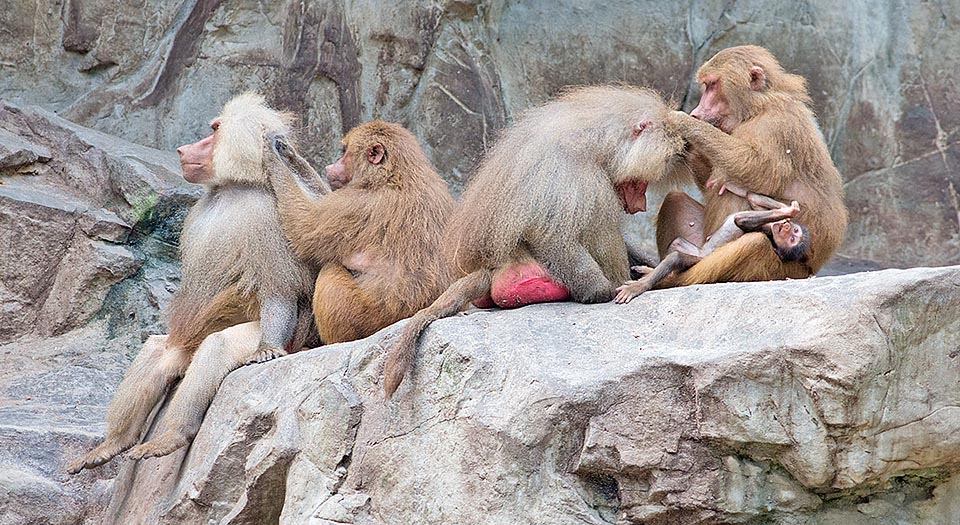
The alpha-males are the first to get the “grooming”, the hair cleaning, by their own females © Giuseppe Mazza
The tail is long and curved. The muzzle is long and protruding, similar to that of a dog, and in the males is equipped with long sharp canines; the brow ridges are much pronounced and the limbs are long and slender. The infants are covered initially by a black down, that they lose when about six months old to acquire the brown-olive colouration of their mothers.
Ecology-Habitat
Papio hamadryas nourish of grass, fruits, roots, tubers, seeds, leaves, buds and insects, but do not disdain small mammals, such as hares and young gazelles, displaying purely omnivorous habits.
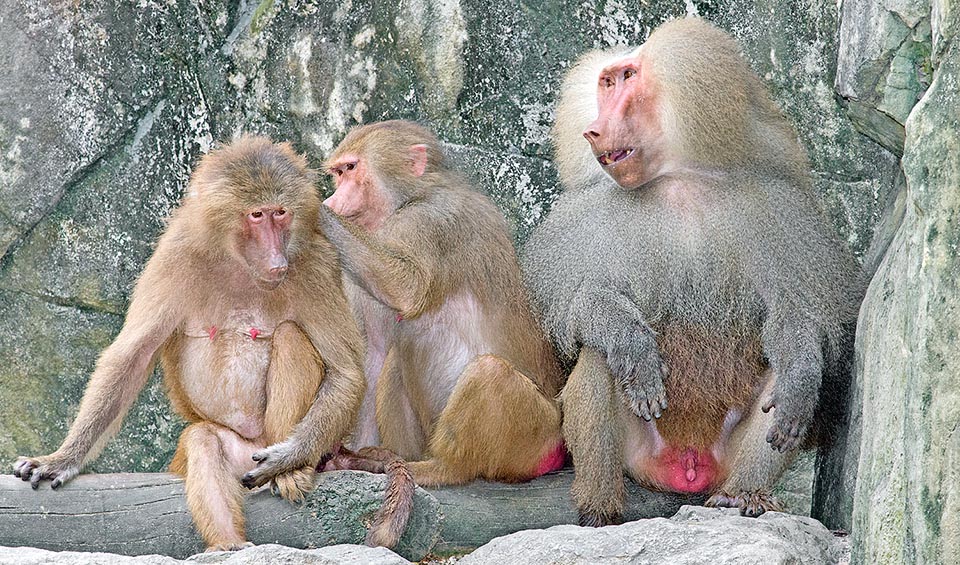
Then these ones curry among them under the attentive eye of the alpha-male who leads the flock and punishes disobedient females with blows and bites. Sexual dimorphism is enormous: apart canines and fur, the adult males of this species can easily exceed the 20 kg whilst the females just reach the 10 kg © Giuseppe Mazza
They are mainly terrestrial but spend the night on the trees or on the cliffs, a factor that, along with the availability of water, heavily affects the geographic distribution.
Ethology-Reproductive Biology
The social organization of Papio hamadryas appears very complex, one of the most sophisticated in the animal world. It is defined as “multilevel”, as we can identify various social “levels” that, starting from the single harems, develop in clans, bands, and then in troops. Let us see more in detail what these very organized baboons have invented.
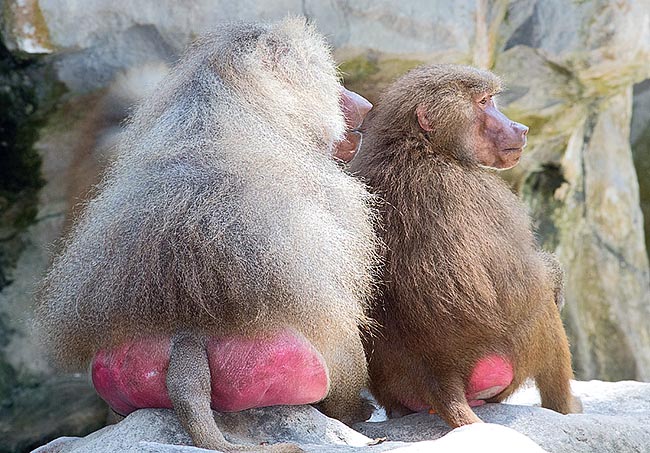
The alpha-male tends to suppress as much as possible the aggression issues between the harem females, avoiding the social stratification, whilst these do conversely compete for getting the attentions of their groom © G. Mazza
The hamadryas baboons live in big familiar groups defined harem or OMU (one-male unit) formed by one male, in the rôle of “paterfamilias”, and by a group of females, up to 10, with their progeny, whom the male keeps under strict control, maintaining the exclusive right of coupling with them and hindering them any contact or form of socialization with other males.
The “paterfamilias” usually keeps linked for years with its own females, who compete continuously for getting the attention of their “groom”.
Inside the harem, in fact, the male alpha is the main object of “grooming” by its females, who brush down its hair continuously, especially at the level of the mane, of the face and of the buttocks. It’s he, in fact, to lead the flock, establishing its movements and puni- shing the disobedient females.
However, at times, the families may by followed by some solitary “satellite” males, who may be related with the alpha male.
As we previously said, the harems do represent only the bricks of what is a very delicate network of relationships and balances among all the members.
The leaders of the various harems can, as a matter of fact, interact and cooperate, being also them strictly related, giving life to clan that may reach a high population, to include 60-90 individuals.
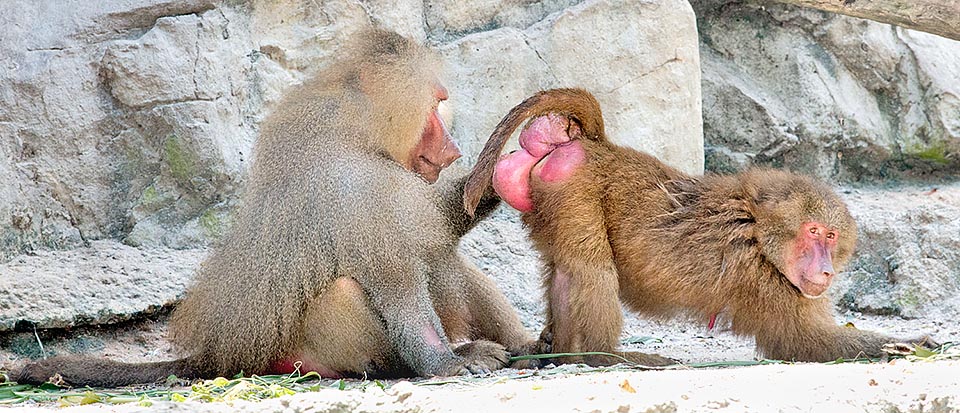
They are the ones taking the initiative offering the rear, swollen due to the ovulation, to male, who carefully controls it before mating © Giuseppe Mazza
In their turn, more clans, usually 2 to 4, can share the same sites of night rest, living together in large groups of more than 200 individuals, known as bands. The males as well as the females rarely abandon the band to which they belong and the alpha-males of the harems forming it are the first fighters to go on the pitch in case of clashes with enemy gangs.
The satellite-males, on the contrary, display a lesser degree of fidelity towards the bands, possibly moving from one to another.
Finally, more bands can form a troop , social level that distinguishes for the sharing of the same night rest place by all its members.
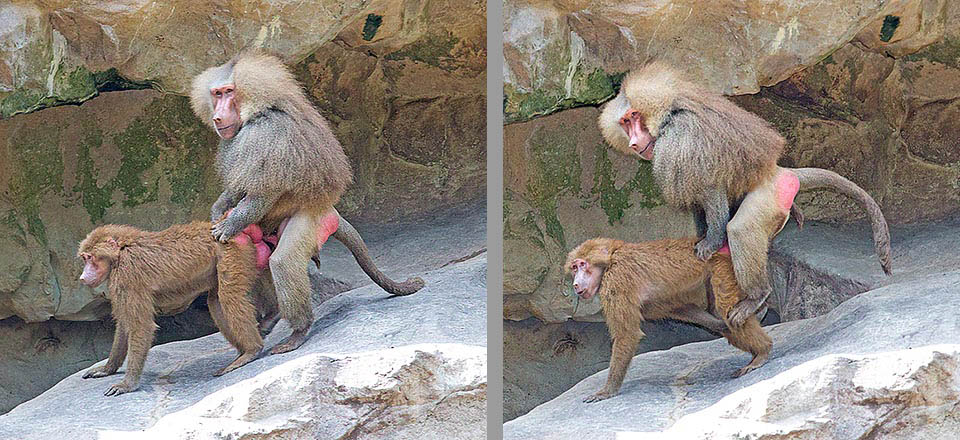
It is then repeatedly mounted up to ejaculation. The coupling frequency during the days of maximum receptivity is very high, reaching even the 7-12 times per hour © Giuseppe Mazza
In this extremely rigid pyramidal organization the youngest males must prove smart and patient for acquiring females in their turn and form new harems.
These subordinate males have two possibilities for increasing their reproductive potentialities: in many cases a subordinate male can enter an already defined harem, staying well far from the females and not displaying any reproductive behaviour towards them, but limiting to follow the group, foraging and resting together with it. In this way the male begins to gain “the confidence” of the females and, slowly slowly, to narrow the gap by keeping an eye especially on the youngest females until the sexual development is reached.
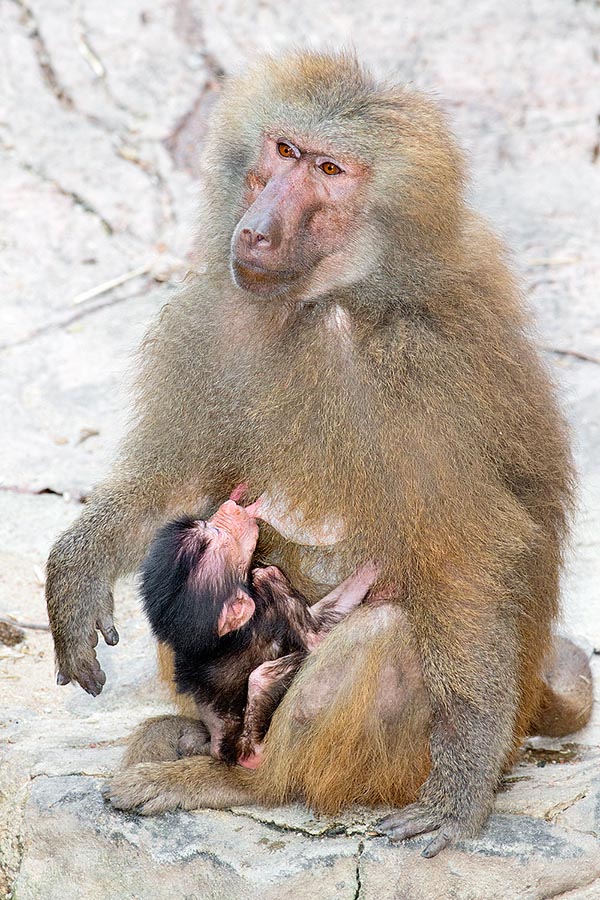
The females have a very different colouration, brown-olive. The breastfeeding duration depends on several ecological and social factors that stand in addition to the mother’s physical conditions © Giuseppe Mazza
The strategy precisely consists in “adopting” a young or subadult female, caring it and reserving great attention. This is a more secure strategy for the male-satellite, as, being the female sexually immature, the alpha-male is less interested in this one.
The patient satellite males, however know quite well that they invest their energies in a fruitful way: when the adopted female will be adult, it will keep in the due consideration the male ho has cared it and so will remarkably increase, for it, the possibilities of creating a harem for its own. In fact, when the male manages to establish its dominance of the adopted female, forming a pair, it will automatically acquire much more attraction from other females of the harem, that will begin to feel attracted by it.
However the modality followed by many subadults is that of stealing the whole harem to the dominant male, after having acquired the appropriate level of familiarity with the females, deposing the old leader.
This system ensures that the females can change clan or leader during their life: it has been noted that about the 70% of the females move from an OMU to another during their life and the change seems influenced by the presence or not of related females in the new harem the female chooses to join.
The modality whereby the females select a new harem where to move allows, often, to maintain the contacts with the other related females for the whole life.
Obviously, the alpha-male monitors carefully its females, and does not fail to inflict heavy punishments to the most undisciplined: in the case it notices one of its “women” in compromising postures with other males-satellite, does not think twice to intervene chasing, shoving and biting the potential traitress.
At this point one wonders what can lead a female to expose itself to the risk of incurring a so deadly wrath: it is thought that the females, mating with other males, making more confused the paternity inside the group avoiding in this way that the males implement infanticide attitudes towards the young of which they are not sure to be the fathers. An infant might be, in fact, the son of the leader, what is true in most of the cases, but might be the son of one of the males-satellite: in the case that this one seizes the power, deposing the old leader, will less likely kill the infant.
The females of Papio hamadryas have typically an oeastral cycle of 31-35 days, of which the first three, in absence of conception, are characterized by a remarkable menstrual flow.
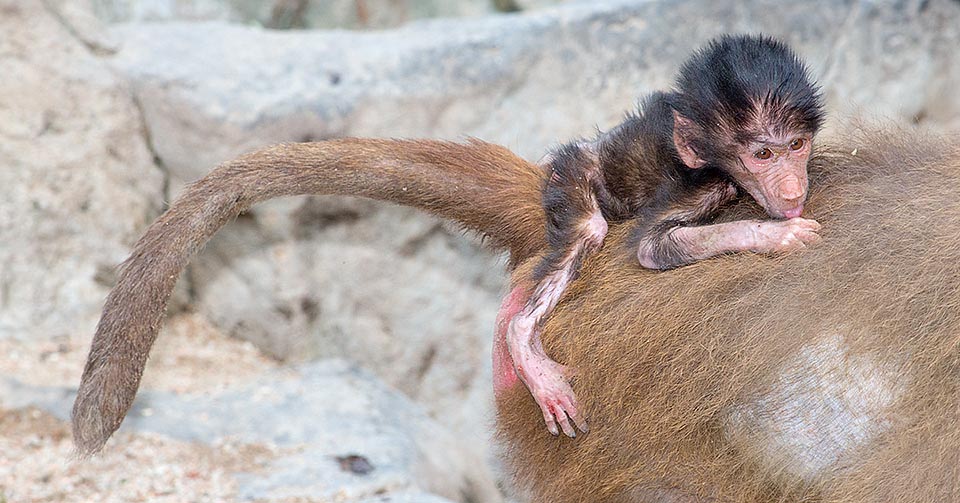
Upon birth the newborns weigh 600-900 g. During the first months they totally depend on the mother until when they begin to eat solid food and are able to walk © Mazza
Conversely, during the days of ovulation, the perianal skin swells to communicate the male the sexual receptivity of the female. The mating occurs following a stereotypical mode: the act is initiated by the female, who offers its back part to the male, that mounts it repeatedly to ejaculation. The frequency of the mating during the days of maximum receptivity is very high, reaching even the 7-12 acts per hour.
Usually when a new male gets the female of an harem, this one develops immediately the typical swellings of the genitals, even if this is not going ahead together with a real oestrus: it is reasonable to think that this “fictitious” oestrus serves to “mislead” the new leader making it believe that the female involved is sexually receptive in order to avoid that it may kill the progeny she has had with the previous alpha-male.
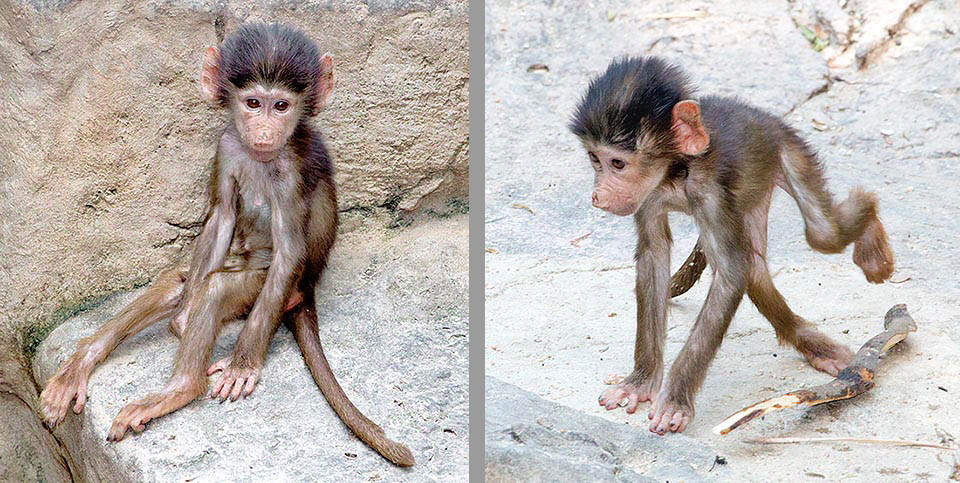
Initially they are covered by a black down they lose when six months old to get their mothers’ colouration © Giuseppe Mazza
The pregnancy lasts about 6 months, after which the female gives birth to only one infant; the births occur mainly during the months between May and July, but for the Ethiopian hamadryas baboons, for whom the months where is reported the highest number of births are November and December.
Between the delivery and the successive one usually elapse two years, but there is a high inter-individual variability: some females are able to generate one son per year, others one every three, reflecting probably differences in the nutritional status and in the level of stress of each single female.
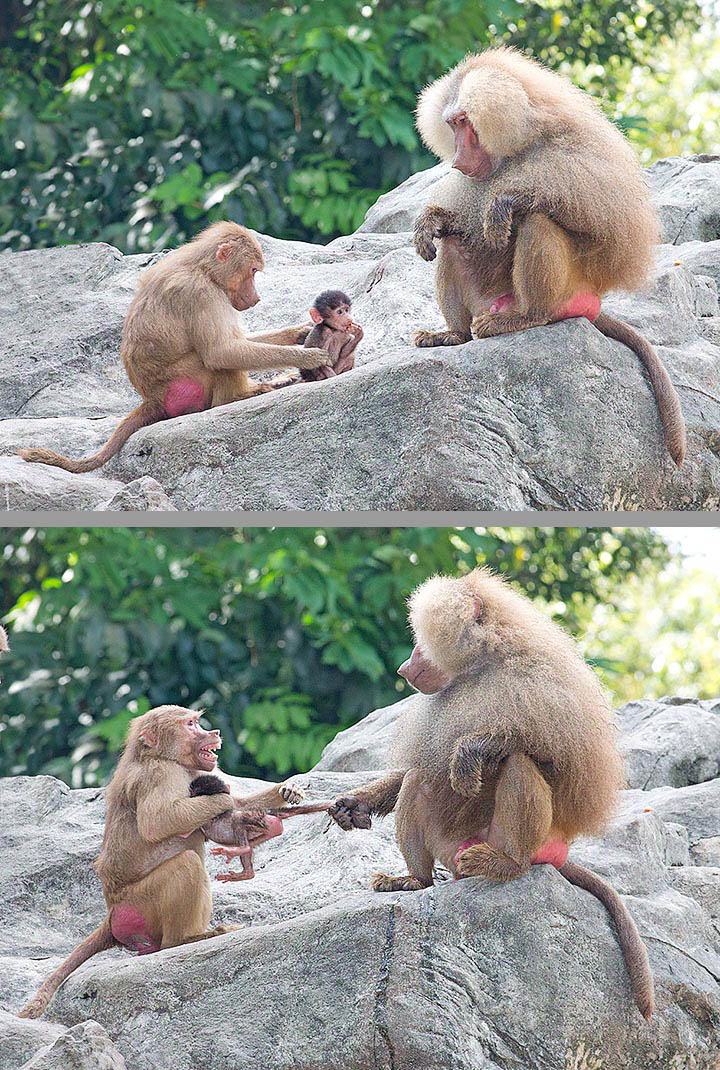
This female introduces the son to the alpha-male. “Did you do it with another?” Seems to say, and seizes it by the tail while the poor thing tries to react. The alphas have right of life or death on the sons they think illegitimate © Giuseppe Mazza
The newborns are black, weigh about 600-900 g, have bright pink skin and are completely depending from the mother during the first months, until when they begin to eat solid food and are able to walk alone. The weaning occurs between the 6 and the 15 months: the duration of the breastfeeding varies on the base of several factors of ecologic and social nature, besides being based on the physical conditions of the mother.
The females administer the infants almost all the parental cares: they look after them, brush down their hair and dedicate not only to their own sons, but also the other females infants belonging to the harem. Furthermore, the young can continue in having very close relations with their mothers also after they become independent from them, being this a species where the sociality is extre- mely developed.
However, also the father plays its part: it defends the progeny against the predators, avoiding as much as possible that the others males of the group get in touch with them.
The sexual maturity of Papio hamadryas is reached when 5 to 7 years old in the males and around 4 in the females. For what concerns the body size, in the males the adult size is reached around the 10 years of age, whilst in the females, that remain re- markably smaller, around the 6. The sexual development in the males appears as a particularly complex process: the testicles get bigger at a different rhythm than the rest of the body. Between the 4 and the 6 years they have already reached the maximum size, whilst the body doubles its size only between the 7 and the 8 years. Obviously, all this has a specific meaning: it is thought, in fact, that in this way the subadult males, having no harem, can sneak more easily inside the others’ harems, not having yet the size of an adult, but being sexually mature may mate with some female thus creating their own OMU.
On the other hand, the delayed acquisition of the secondary sexual characters should have mainly the function of maintaining of the harem: the development of the silvery mane, of the clearly coloured cheeks and buttocks should exert much charm on the females, pushing them to remain with the alpha-male and entitling him to an extremely high rate of “grooming”.
Cland, bands and troops operation
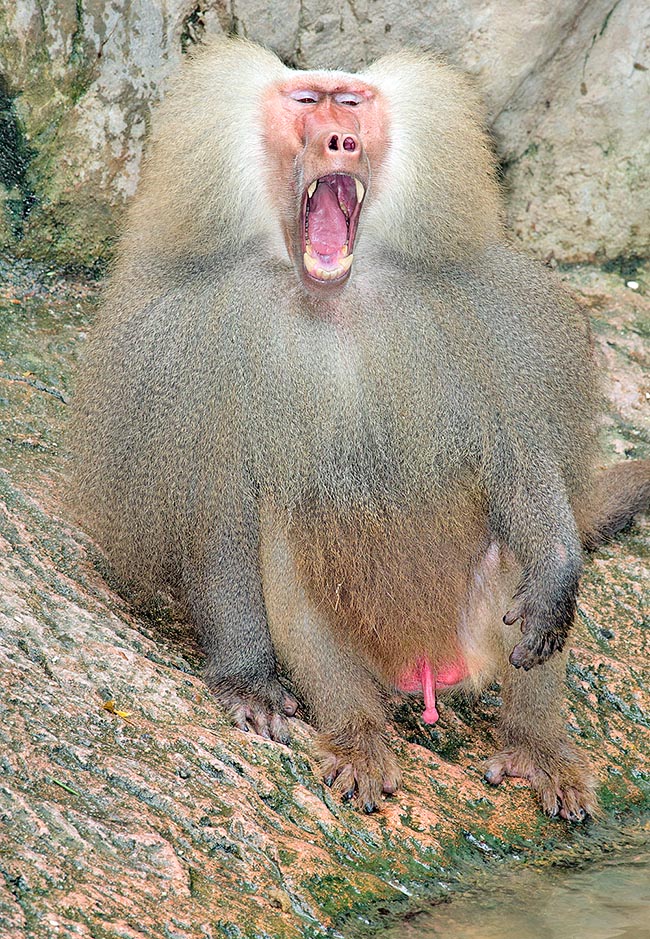
Teeth are often shown as menace. Every morning the alpha-males of the band make arrangements about the water pond where to gather by noon. The union allows in fact to compete with other species © Giuseppe Mazza
The social organization of the baboons appears, as we have seen, extremely complex and based on a pyramidal structure that, starting from the single OMU, leads to the formation of clans, then of bands and finally of troops. Why do the baboobs associate in groups increasingly bigger?
The formation of bands seems to be important in order to allow the hamadryas baboons to compete for the access to the water ponds and to the night rest sites. Every morning, the various alpha-males belonging to the same band make arrangements about the water pond close to which they will gather by mid-day. The agreement happens in a very simple way: an alpha-male makes some steps in direction of the water pond where it wants the band to gather, and if also the other leaders agree with its choice, they will also move some steps in the same direction.
To communicate, instead, that they would like to visit a different one, they will move some steps in the direction of the other pond. Eventually, the winning pond will be the one towards which more leaders will move: that will be the site chosen for the noon meeting.
From then on the various OMU will disperse looking for food, and will meet at noon, as per the agreements taken, by the chosen pond.
It is very important that all clans are present at the right time and place: the water pond represents an important ressource for quite many other animals and the main advantage, for the hamadryas baboons, in gathering in dense groups is rightly that of getting the access to the water.
Same proceeding goes for the choice of the night rest sites, where the various bands of baboons gather in troups. It seems, in fact, that in the case of the troops there is not a real social meaning, as is the case of the bands, but that the baboons are “obliged” to unite in very big groups especially due to the scarcity of places suitable to be exploited as night shelters.
A typical peculiarity of the hamadryas baboons is that of associating in bands where are family relationships among the various members: in spite that the males can form their own harems, separating from the origin one, they never go too far from the relatives, as all will tend to remain inside the same band.
These blood ties are those that, it’s thought, determine the degree of respect in force inside the bands: most unlikely a leader of an OMU will make the “Don Juan” with the females of another OMU.
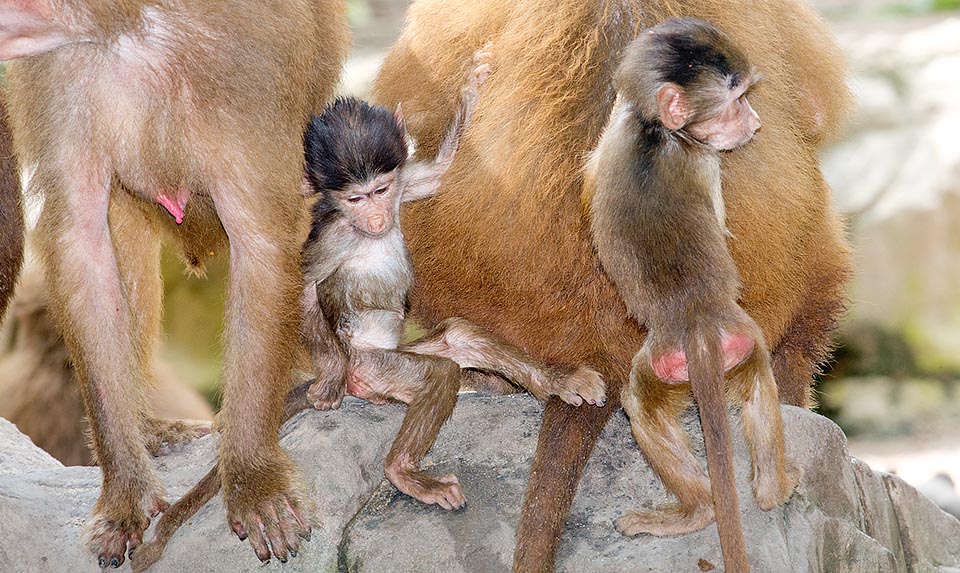
The harem females help each other in the maternal cares. The pregnancy lasts about 6 months and generate one kid only, usually every 2 years © Giuseppe Mazza
We have finally seen how also for the females applies in some way the same rule: they try to move into OMU where are sisters or relatives and it is not rare, in fact, that two females coming from the same origin group transfer, when adult, in the same OMU.
In spite of this, inside the harems is present a “pseudo-dominance” also for what concerns the females: the alpha-male tends to repress as much as possible the aggressiveness cases among its female companions, thus avoiding the social multilevelling.
However, inside a family we can identify some females defined as “central”, that spend more time close to the male and have a stronger link with it, and other females, called “peripheral” that spend less time with the leader and are often used by the group for going in reconnaissance close to the foraging sites or the water ponds, exposing to a greater predation risk.
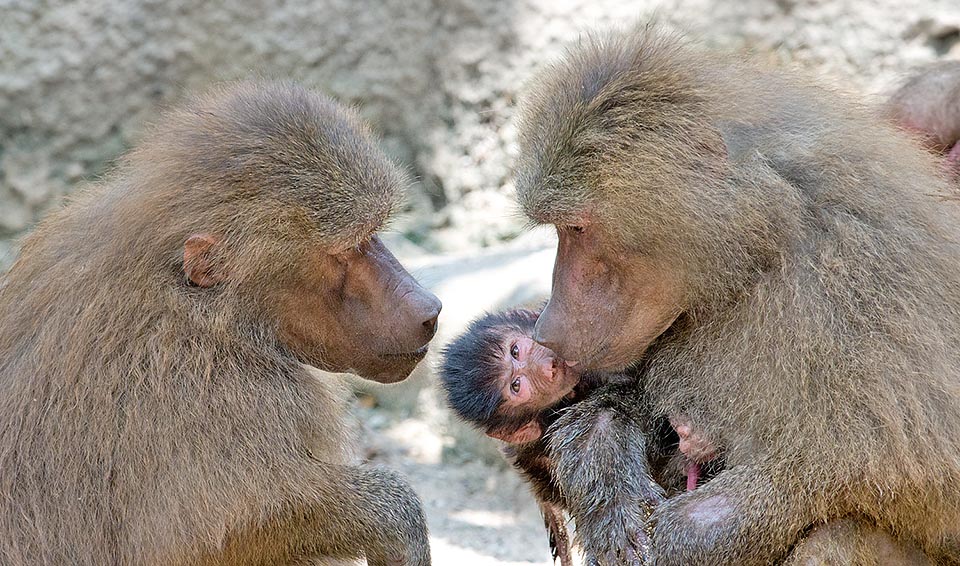
Consultation between mothers. “Look, it has not well digested the food”. “Come on, it’s nothing, Trust me, that I have had so many” © Giuseppe Mazza
It is clear that this discrimination creates inside the harem competition among the females for entering the graces of the alpha-male. This could justify the swellings of the genital zones the females meet just after that a new male takes possession of an OMU: we have said that this “false” oestrus might avoid or reduce infanticide behaviours of the new leader, but might also serve for getting matings with the new leader immediately, in order to form with him a firm bond.
Intraspecific communication
Such sophisticated social organization requires, of course, an equally complex and effective modality of communication. The hamadryas baboons communicate by means of a code done of gestures, looks, rubbings, vocalizations, and, in a very small part, odours.
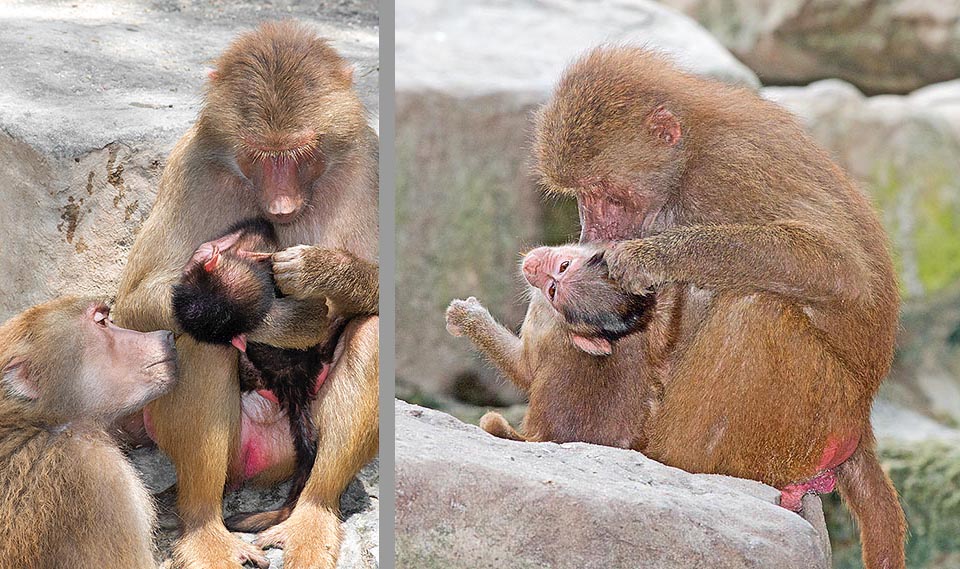
But, did you clean him well? It seems to me that it stinks a little… and always remember not to forget the ears © Giuseppe Mazza
Among the most important forms of visual communication for the species stands by sure the presentation of the rear to the dominant male by the females and young of the group as a sign of submission, well different signal from that the female uses for informing him about her availability to the mating: in the first case, in fact, the rear keeps much lower, close to the soil. The males communicate, then, their ominous intentions against other males watching intently and showing the canines, whilst the vocalizations are emitted as signal of warning or of affiliation.
In Papio anubis the females, when in oestrus, produce a series of odorous substances, with the purpose of becoming even more attractive towards the male and it is thought that the same thing may apply to Papio hamadryas. The tactile communication, conversely, develops in form of “grooming”, obviously, but also through reassuring hugs and chafings, as well as through slaps and blows in the case of competition.
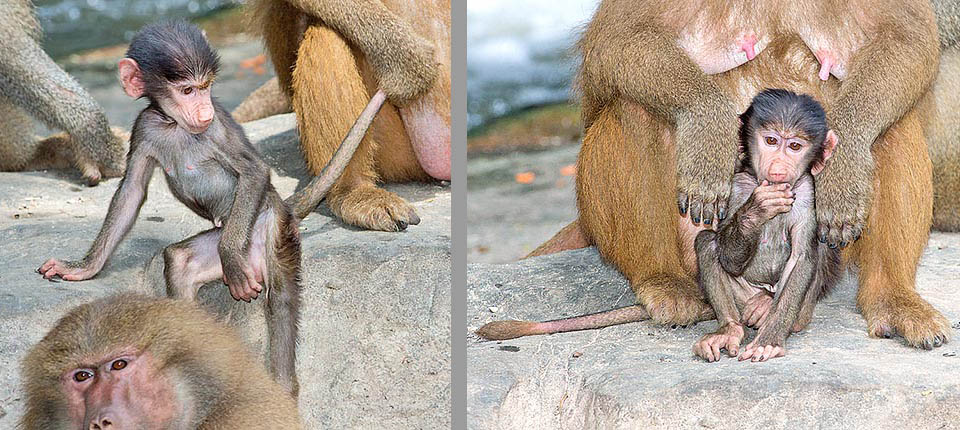
The tail is often used as leash. After having caught him, this mother blocks the tail with all her weight and lines him with the hands © Giuseppe Mazza
Curiosities
In some areas of Ethiopia it seems that Papio hamadryas shows migratory habits: some populations have been observed while moving in the mountain zones in the Simien Mountains National Park, up to 3300 m of altitude, during the rain season.
Real and proper predators of Papio hamadryas are not presently known in most of its range, but it is thought that the evolution of a sophisticated social organization is also the result of the predation to which it has been subject in the past times: meeting in great number close to the water ponds helps in facing with greater safety possible predators, as well as the choice of cliffs and rocks placed at a certain height as night shelters reveals the necessity, at least in the past, to be safe from dangers, this last being a factor, as already said, that may explain the birth of the troops.
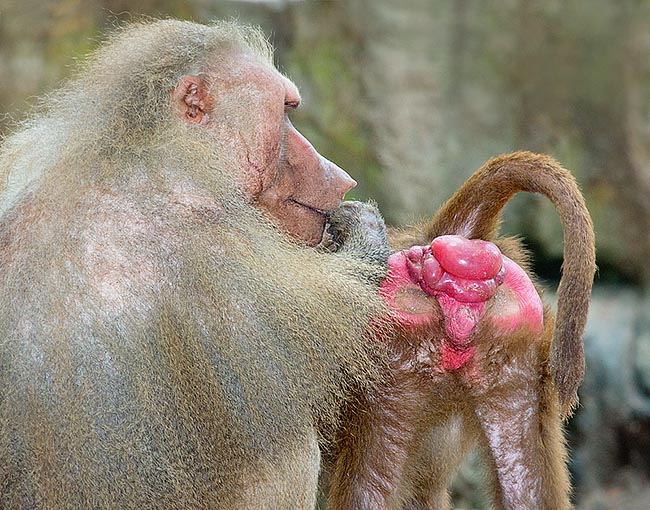
What happens to the ousted old ones? This thoughtful and sprightly old little man doesn’t know whether to accept the alluring proposal of the young unfaithful female that may cause to both big problems © Giuseppe Mazza
Papio hamadryas can hybridize with Papio anubis, the olive baboon, in a northern Ethiopean region, where the ranges of the two species do overlap.
The maximum length of the life in captivity has been recorded as of 37 years; in the wild it is thought that the figure may be slightly lower.
The hamadryas baboons have enjoyed for long time of a very prestigious reputation: old Egyptians regarded them as sacred, as being the animal a transfiguration of the god Thoth, god of knowledge, of writing and of the moon. In fact, in the Egyptian art is quite frequent to meet depictions of the divinity featured as hamadryas, as well as shaped like an hamadryas was represented Astennu, Thoth’s guardian who had the delicate job of writing down the results of the weighing of the heart.
It is thought that this attribution of sanctity to the hamadryas is to be found in the close relationship that incurred between them and the old Egyptians, who tamed them in order to pick up the fruits on the trees or even for guarding flocks of sheep, as if they were sheep dogs. Another explanation, on the contrary, affirms that the hamadryas were object of worship as in some of their behaviours the old Egyptians did see a sort of a veneration for the sun.
Populations of Hamadryas baboons are increasing and since 2019 Papio hamadryas has been listed as “LC, Least Concern” on the IUCN Red List of threatened species.
Synonyms
Hamadryas aegyptiaca Gray, 1870; Hamadryas chaeropitheus Lesson, 1840; Papio arabicus Thomas, 1900; Papio brockmani Elliot, 1909; Simia cynamolgus Linnaeus, 1758; Theropithecus nedjo Reichenbach, 1863; Cynocephalus wagleri Agassiz, 1828.
→ For general notions about Primates please click here.
→ To appreciate the biodiversity within the PRIMATES please click here.
